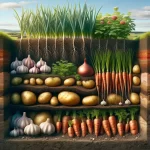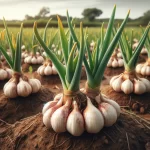The cultivation of garlic (Allium sativum) is an ancient practice valued for its culinary and medicinal uses. For farmers, understanding and properly managing the phenological stages of garlic is crucial to achieving high-quality yields. The phenological stages describe the plant’s life cycle from planting to harvest, each with specific characteristics and requirements. In this introduction, we will explore the main phases of garlic development, from germination and vegetative growth to bulb formation, maturation, and harvest. This knowledge is fundamental not only for optimizing agricultural practices but also for ensuring that the cultivated garlic reaches its maximum potential in terms of flavor and nutritional value. Join us in this journey through the phenological stages of garlic, a crop that remains essential in agriculture and gastronomy worldwide.
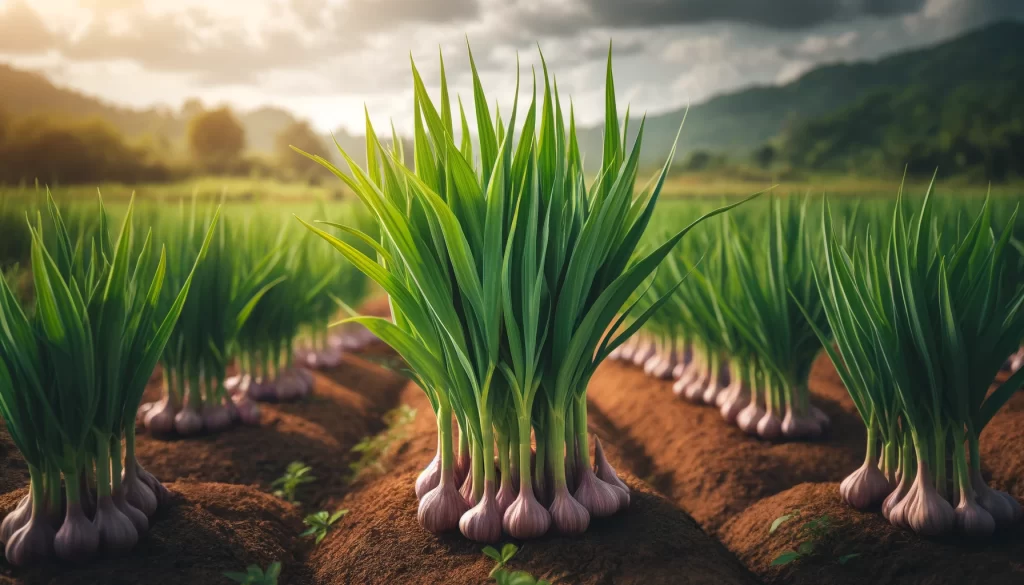
Phenological Stages of Garlic with Technical Description and Best Practices
1. Germination
During germination, garlic is typically planted in the fall or winter, depending on the local climate. The optimal temperature for this process ranges from 10 to 15°C. In this phase, garlic cloves begin to sprout roots and green shoots, a process that can take between 2 and 4 weeks.
Best Practices:
- Seed Selection: Use healthy, preferably large garlic cloves without signs of disease or damage.
- Soil Preparation: Till the soil to improve aeration and drainage, maintaining a pH between 6 and 7.
- Planting: Plant the cloves at a depth of 2-3 cm, with the pointed end facing up, and space them 10-15 cm apart, keeping a row spacing of 20-30 cm.
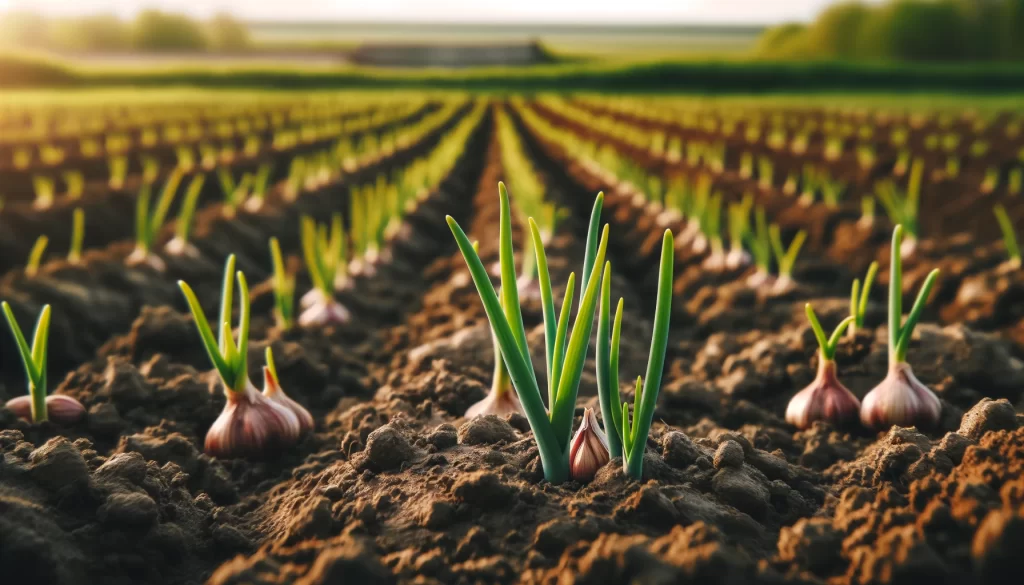
2. Vegetative Development
In this stage, green leaves emerge and grow rapidly, forming a rosette that is crucial for photosynthesis and plant development. Simultaneously, roots deepen and spread in the soil, absorbing necessary nutrients and water for growth.
Best Practices:
- Irrigation: Provide regular watering, keeping the soil moist but not waterlogged to avoid water stress.
- Fertilization: Apply a balanced fertilizer rich in nitrogen to promote foliar development. Use compost or organic fertilizers if possible.
- Weed Control: Keep the area weed-free through manual weeding or the use of selective herbicides.
3. Bulb Formation
During bulb formation, the bases of the leaves begin to thicken, forming garlic cloves. This process continues with the thickening of the cloves, where the nutrient reserves are stored.
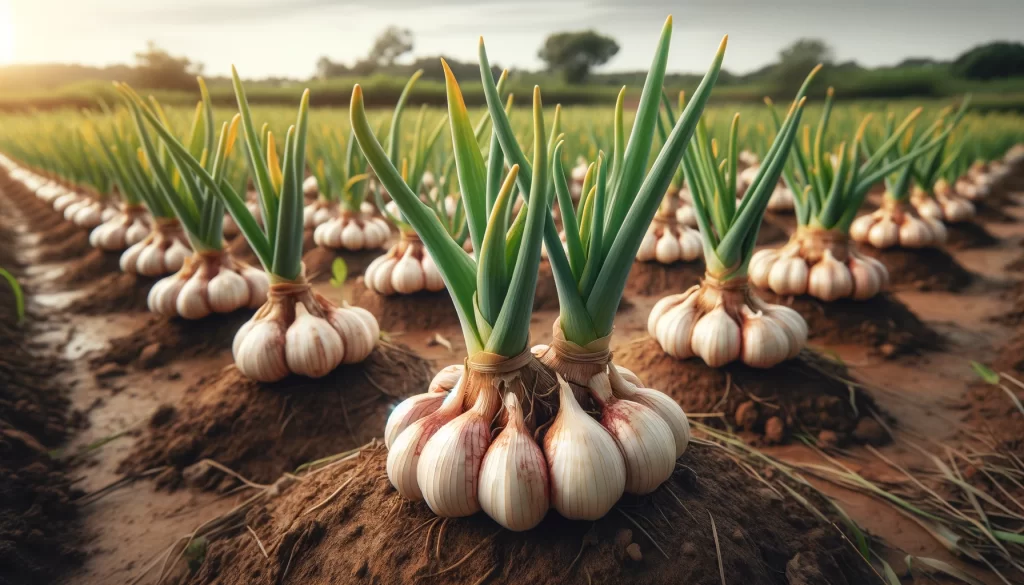
Best Practices:
- Irrigation: Gradually reduce watering to prevent bulb rot.
- Fertilization: Decrease nitrogen supply and increase potassium and phosphorus to promote bulb formation and thickening.
- Plant Support: Provide support if necessary to prevent plants from bending and getting damaged.
4. Maturation
In the maturation phase, the bulbs reach their maximum size and begin to mature, evidenced by the yellowing and dying of the lower leaves. The senescence of the leaves indicates that the bulbs are nearly ready for harvest.
Best Practices:
- Irrigation: Suspend watering once the leaves start to yellow to allow the bulbs to mature and dry properly.
- Pest Protection: Continue monitoring and managing pests and diseases, treating with specific products if necessary.
- Sampling: Take samples of bulbs to assess their size and maturity before proceeding with the general harvest.
5. Harvest
The ideal time for harvest is when the lower leaves are dry and the upper leaves start to yellow but before they completely dry out. Bulbs should be carefully extracted to avoid mechanical damage, using appropriate tools.
Best Practices:
- Extraction: Carefully extract the bulbs using appropriate tools to avoid damage. A fork can help loosen the soil.
- Drying and Curing: Place the bulbs in a dry, well-ventilated area for several weeks to cure. This improves the storage and flavor of the garlic.
- Storage: Store the bulbs in a cool, dry, and dark place, preferably hung in bunches or in boxes with good ventilation to prevent rot.

Implementing these best practices at each stage of the garlic life cycle is essential to maximize yield and quality. Each phase has its own challenges and requirements, and attention to these details can make a significant difference in the success of the harvest.
Phenological Stages of Garlic, Estimated Duration in Days of Each Stage, and Nutrient Recommendations per Hectare
| Phenological Stage | Duration (days) | Nutrient Recommendation (kg/ha) |
|---|---|---|
| Germination | 14-28 | N: 40-50, P: 20-30, K: 20-30 |
| Vegetative Development | 30-60 | N: 100-120, P: 30-50, K: 50-70 |
| Bulb Formation | 60-90 | N: 50-60, P: 40-50, K: 80-100 |
| Maturation | 20-30 | N: 20-30, P: 20-30, K: 40-50 |
| Harvest | Varies by conditions | N/A |
 AgronoBlog – Agriculture Blog
AgronoBlog – Agriculture Blog 